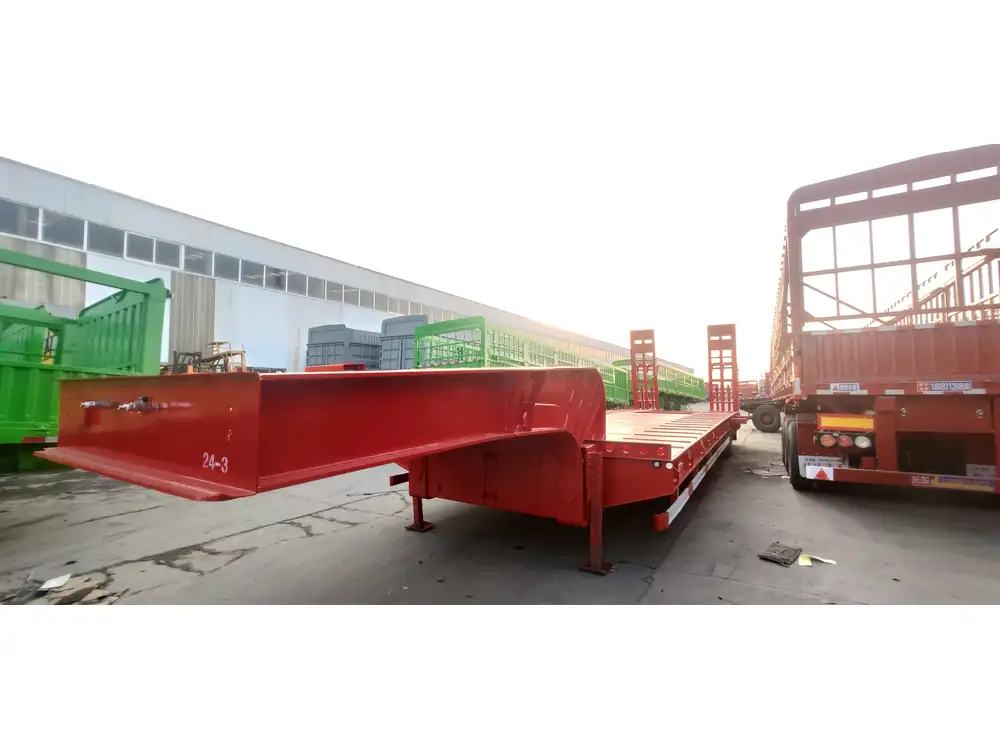Introduction to Semi-Trailer Weights
When it comes to transporting goods efficiently, knowledge about the weight of semi-trailers is crucial. The weight of an unloaded semi-trailer affects a multitude of factors: from fuel efficiency to legal regulations regarding road safety. In this article, we will explore the specific area of unloaded semi-trailer weights, particularly focusing on the 35 ft trailer, thus providing you with valuable insights that can influence operational choices in the logistics industry.
What Influences the Weight of a Semi-Trailer?
The weight of semi-trailers is not a one-size-fits-all matter. Various factors contribute to the overall weight of an unloaded trailer:
Material Composition:
- Aluminum vs. Steel: Aluminum trailers are lighter, typically weighing around 4,000 to 6,000 lbs (1,814 to 2,722 kg), whereas steel trailers might weigh between 6,000 to 8,000 lbs (2,722 to 3,628 kg). The material choice impacts the durability and efficiency of the trailer.
Design and Structure:
- Flatbed vs. Enclosed: Flatbed trailers usually weigh less due to their simplistic design compared to enclosed trailers, which have additional panels for protection and strength.
- Single Axle vs. Tandem Axle: Tandem axle trailers distribute weight over two sets of wheels, which can add to the weight but enhance load-bearing capacity.
Additional Features:
- Dolly and Landing Gear: Optional features such as hydraulic lifts or specialized mounting points can affect the weight.
- Weight Distribution Systems: Innovations for load distribution can also change the unloaded weight of the trailer.
Accessories:
- Ramps, Tarps, and Toolboxes: These add-ons can increase weight, affecting the total transport capabilities.

Table: Approximate Weights of Different Types of 35 ft Semi-Trailers
| Type of Trailer | Approximate Unloaded Weight (lbs) | Approximate Unloaded Weight (kg) |
|---|---|---|
| Aluminum Flatbed | 4,000 – 5,000 | 1,814 – 2,268 |
| Steel Flatbed | 6,000 – 7,000 | 2,722 – 3,175 |
| Enclosed Aluminum | 5,500 – 6,500 | 2,495 – 2,948 |
| Enclosed Steel | 7,000 – 8,000 | 3,175 – 3,628 |
| Tandem Axle Flatbed | 6,000 – 8,000 | 2,722 – 3,628 |
Average Weight of an Unloaded 35 ft Semi-Trailer
For a standard 35 ft semi-trailer, the unloaded weight typically falls within the 4,000 to 8,000 lbs (1,814 to 3,628 kg) range depending on the construction materials and design. This broad range illustrates how individual specifications can influence weight – a critical consideration for businesses planning transportation logistics.
Factors to Consider for Weight Calculations
Payload Capacity: Understanding how much additional weight your trailer can carry is crucial for compliance with weight limits. The average payload capacity of a 35 ft empty trailer generally ranges from 25,000 to 40,000 lbs (11,340 to 18,144 kg).
Load Distribution: An even distribution of weight across the axles can prevent premature trailer wear, increasing lifespan and performance.
State and Federal Regulations: Each jurisdiction has its weight limits for both individual trailers and combined vehicle weights. Knowing the unloaded weight is essential to avoid legal complications and fines.

The Importance of Knowing Your Unloaded Trailer Weight
Understanding the unloaded weight of a semi-trailer is vital for:
Fuel Efficiency: Heavier trailers require more powerful tractors, which equates to higher fuel consumption. Using lighter trailers can significantly reduce transport costs.
Safety Standards: Overloaded trailers can create hazardous road conditions. Knowing the unloaded weight will help carriers stay within permissible limits.
Licensing Requirements: Licensing varies based on the weight class. Trucks exceeding particular weight limits may need specialized licenses.
Equipment Selection: Matching the right tractor to your trailer weight is essential for optimized performance. You wouldn’t want a heavy semi-truck pulling an ultra-light trailer, or vice versa, as this can lead to inefficiencies in both power and cargo management.
Checklist: How to Calculate and Optimize Weight Efficiency
- Identify the Material of your trailer and axle configuration.
- Calculate the unloaded weight based on manufacturer specifications.
- Determine the maximum payload capacity according to state and federal regulations.
- Optimize cargo distribution to prevent overloading on any specific axle.
- Regularly assess the condition of the trailer to ensure longevity and compliance with weight standards.
Future Considerations for Semi-Trailer Design
In recent years, technological advancements have led to the development of lighter and more robust materials. The logistics industry is moving towards not just efficiency but also sustainability. Here are trends that may shape tomorrow’s semi-trailer designs:
Composite Materials: Utilizing carbon fiber or similar materials not only reduces weight but could also improve durability and lifespan.
Smart Trailers: With IoT integration, trailers can report real-time weight, helping businesses optimize load and increase safety.
Aerodynamics: Improved design can significantly affect fuel efficiency; adding skirts and spoilers can reduce drag, leading to better overall performance.

Comparative Analysis of Conventional vs. Modern Trailers
| Feature | Conventional Trailers | Modern Trailers |
|---|---|---|
| Material | Steel, Aluminum | Aluminum, Composites |
| Average Unloaded Weight | 6,000 – 8,000 lbs | 4,000 – 6,000 lbs |
| Load Distribution Techniques | Manual | Automated IoT Integration |
| Fuel Efficiency | Moderate | High |
| Compliance Tracking | Manual | Real-time Monitoring |
Conclusion
The unloaded weight of a 35 ft semi-trailer plays a pivotal role in logistics and transportation safety. Businesses must grasp this fundamental aspect to optimize performance and stay compliant with regulations. Understanding how weight impacts overall efficiency can lead to better decisions regarding trailer selection and operational strategies.
By continually keeping abreast of innovations in materials and technology, transport companies can enhance their efficiency, safety, and sustainability initiatives, ensuring a smarter approach to road transportation.
Engaging with the nuances of semi-trailer weight can facilitate significant competitive advantages in the evolving logistics landscape. As businesses adapt to these changes, having an accurate and comprehensive understanding of trailer specifications will be instrumental in streamlining operations and maximizing profits.



